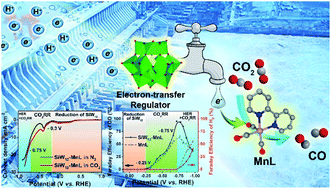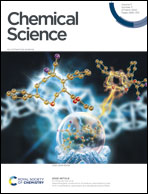Polyoxometalate-based electron transfer modulation for efficient electrocatalytic carbon dioxide reduction†‡
Abstract
The electrocatalytic carbon dioxide (CO2) reduction reaction (CO2RR) involves a variety of electron transfer pathways, resulting in poor reaction selectivity, limiting its use to meet future energy requirements. Polyoxometalates (POMs) can both store and release multiple electrons in the electrochemical process, and this is expected to be an ideal “electron switch” to match with catalytically active species, realize electron transfer modulation and promote the activity and selectivity of the electrocatalytic CO2RR. Herein, we report a series of new POM-based manganese-carbonyl (MnL) composite CO2 reduction electrocatalysts, whereby SiW12–MnL exhibits the most remarkable activity and selectivity for CO2RR to CO, resulting in an increase in the faradaic efficiency (FE) from 65% (MnL) to a record-value of 95% in aqueous electrolyte. A series of control electrochemical experiments, photoluminescence spectroscopy (PL), transient photovoltage (TPV) experiments, and density functional theory (DFT) calculations revealed that POMs act as electronic regulators to control the electron transfer process from POM to MnL units during the electrochemical reaction, enhancing the selectivity of the CO2RR to CO and depressing the competitive hydrogen evolution reaction (HER). This work demonstrates the significance of electron transfer modulation in the CO2RR and suggests a new idea for the design of efficient electrocatalysts towards CO2RR.

- This article is part of the themed collection: Celebrating the 110th Anniversary of chemistry at Soochow University


 Please wait while we load your content...
Please wait while we load your content...